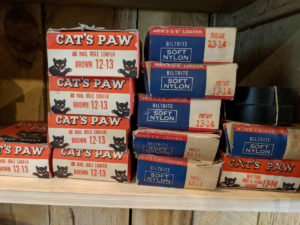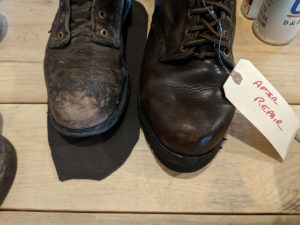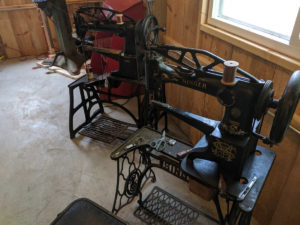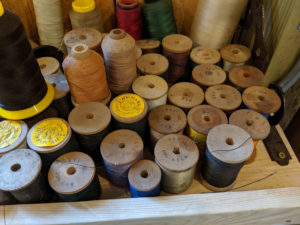Shoe Cobbler Shop
by Gerald Bermel
The 2019 Steam Threshing Show added a few demonstration areas, hoping to a allow folks to watch some old-time crafts and skills that were common in society 50 and 100 years ago. One of those skills and trades that is quickly being lost is that of the shoe cobbler. Because of a donation to LRPTA of some of the shoe repair equipment and materials from the family of Charlie Olesen that formerly had in his shop in Hoffman, MN, the association had a desire to set up an old-time working cobblers shop on the grounds.
Two years ago, a couple of the board members contacted me and asked if I would consider filling the roll of the cobbler and set up a shop similar to what one may have seen in almost every town and city in the years past. I come from a pretty long line of shoe cobblers although that wasn’t my trade and career. My great grandfather was a shoemaker and shoe repairman in Germany. As many of the boys and young men did in the old country, my grandpa apprenticed under his father in that trade. He immigrated to the United States and opened a shoe and leather repair shop in Randall, MN in 1917. Harness repair was a major part of his work. My dad took that business over after he returned from WWII and continued doing shoe, leather, and canvas repair. This was a family business so all of us worked in the shoe and clothing store from the time we were in first grade. I always enjoyed watching dad fix shoes and whatever else could be repaired in his shop. In 1967 when I was in the 7th grade I started learning from him and doing some of the easier repairs. At that time binders and swathers were in use for small grains and had a rolling canvas on them. Both grandpa and dad repaired many of those every year – straps, webbing, holes in the canvas, slats, buckles, etc. Dad was so busy in the store and with shoe repair that he turned the canvas work over to me at that time. That was kind of the beginning! Through my junior high, high school and college years I did odds and ends of repairs, learned from my dad, and enjoyed doing it! So I guess that was start of my shoe cobbler apprenticeship! I stayed with it as I could over the years. In 2010 when the old cobbler in Fergus Falls passed away I ran a shop for several months in town.

In the 1950s there were approximately 40,000 cobblers in America. That’s an interesting number when one considers that there were approximately 37,000 cities and towns in America during that time! Most towns and cities had at least one shop, even the small towns. Today there are probably around 6000 to 6500 cobblers working their trade in the U.S. It truly is a lost craft. Many of those that remain are well up in age. Shops have been closing and disappearing quickly in the last several years. There just aren’t young folks interested in taking up that trade. And it is true that so much of what we buy is not good quality and simply get thrown out.
This year
with the addition to the museum building on the steam grounds, a working shoe
cobbler shop was added. The “4th Generation
Shoe and Leather Repair” shop repaired dozens of pairs of shoes, some belting
and tie-down straps, even a lady’s purse! The
main repairs were new soles and heals, and stitching seams that let lose or
became torn. This was all done during the 3 days of the show and several days
after the show! The primary machines are a treadle powered patcher which is a
heavy duty sewing machine. A stitcher, an actual 1920s model that
was loaned to the show by Tim Koenig of Bermel’s shoe store in Randall, MN is
used to do the heavy stitching in thick materials as around the outside edge of
a sole. The finisher is a machine with several abrasives for grinding and
sanding of the heel and sole edges, etc. As well it has attachments for
burnishing leather edges, buffing and cleaning etc. A leather sole trimmer or “5 in one” is a hand crank
trimmer and was also loaned to the show by Bermel’s shoe store. A variety of hand tools are used a lot, and most of these are
just as they were 100 years ago!
There was much interest in the cobbler’s shop by the show visitors. Lots of questions and also a lot of reminiscing by some of the older folks who well remembered the days when it was a common practice to bring shoes to the shoe repair shop! This shop also often served as a place for friendly visiting and that certainly took place during the 3 days of the Steam show in Dalton! 😊 I’m looking forward to filling the role of the shoe cobbler again in 2020!
Gerry Bermel, (son of cobbler exceptional Richard Bermel, grandson of cobbler exceptional Henry Bermel, and great-grandson of shoemaker exceptional Michael Bermel) 😊



